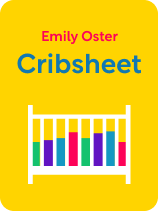

This article is an excerpt from the Shortform book guide to "Cribsheet" by Emily Oster. Shortform has the world's best summaries and analyses of books you should be reading.
Like this article? Sign up for a free trial here.
What should you know about recovery after birth? How can you heal emotionally and physically?
When writing her parenting book Cribsheet, health economist Emily Oster reviewed hundreds of studies and claims she based her recommendations on the most trustworthy, actionable research. In her book, she offers research-based advice on recovering after birth.
Read on to learn Oster’s advice on childbirth recovery, according to her research.
Emotional Recovery After Birth
According to Cribsheet author Emily Oster, recovery after birth isn’t just physical—in fact, research reveals that postpartum depression is a serious, common, and treatable condition that you should seek support for as soon as symptoms show up. Symptoms include feeling anxious, having trouble sleeping, having thoughts of self-harm, and deriving less joy from activities you once loved. Either or both parents can experience postpartum depression after their baby’s birth.
Because postpartum depression can make parenting feel harder, it’s best to treat it early. Doctors typically provide you with a survey to screen for depression at your six-week postpartum appointment. If you’re concerned you or your partner have postpartum depression earlier than this, call your doctor to get screened and treated earlier. Treatment typically includes talk therapy, and in more serious cases, your doctor may also recommend you take antidepressants.
(Shortform note: Although Oster focuses on describing and treating signs of postpartum depression after the baby’s birth, recent research shows that early signs of postpartum depression can appear during a person’s pregnancy. For instance, people who experience mood changes and depression during pregnancy are more likely to also experience postpartum depression. This research suggests that you may be able to seek treatment even before your baby is born.)
Physical Recovery After Birth
According to Oster, the period of physical recovery after birth varies in length, depending on how much trauma the birth did to your body. If you deliver by cesarean section, you’ll have a longer recovery than if you deliver vaginally. Birth complications, such as vaginal tearing, also prolong your recovery time.
(Shortform note: Recent research reveals that people who experience longer periods of recovery after birth can make that time more bearable by engaging in postpartum physical therapy. One randomized trial found that physical therapy reduces post-cesarean delivery pain. Another randomized trial reveals that people who experienced third-degree tearing during delivery felt that pelvic floor therapy improved their quality of life.)
Here, we share Oster’s answers to two common questions about physical recovery after birth:
When can I resume having sex? People often say you should wait until six weeks postpartum, but there’s no data to support this. Instead, determine for yourself when or if to resume having sex based on when you want it and when you feel physically ready (with no discomfort or pain).
(Shortform note: Research reveals that couples tend to have less sex after their child is born, but their levels of sexual activity typically return to normal levels after a year. One factor that contributes to this reduction in sex is fatigue: Parenting is tiring, and couples are less likely to engage in sex when they’re tired. Additionally, when you’re busy caring for a child, it’s harder to pursue your urge for sex when it arises, as it’s less common for both parents to be free to spontaneously follow their impulses. According to experts, if you’re looking to carve out more time for sex postpartum, it helps to schedule regular “sex dates.” Ask a family member or friend to watch your child at their home so you and your partner can enjoy some alone time.)
When can I resume exercise? Exercise as soon as you’re physically able to, since it can help reduce symptoms of postpartum depression. Start with less intense exercise, then gradually increase the intensity. If you had a cesarean section, you can typically begin going on walks two weeks postpartum and resume your normal exercise routine after six weeks. If you had a vaginal delivery without tearing, you can exercise as early as one week after birth.
(Shortform note: What are the best ways to ease back into an exercise routine after having a baby? Experts recommend beginning with stretching, walking, pelvic floor exercises, and movements that focus on your core, such as lying down on your back and repeatedly lifting and lowering your pelvis off the floor.)

———End of Preview———
Like what you just read? Read the rest of the world's best book summary and analysis of Emily Oster's "Cribsheet" at Shortform.
Here's what you'll find in our full Cribsheet summary:
- Why there isn't one right way to parent a young child
- How to make research-based parenting decisions
- When you should start potty training your toddler






